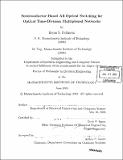Semiconductor-based all-optical switching for optical time-division multiplexed networks
Author(s)
Robinson, Bryan S. (Bryan Shawn), 1975-
DownloadFull printable version (11.89Mb)
Other Contributors
Massachusetts Institute of Technology. Dept. of Electrical Engineering and Computer Science.
Advisor
Erich P. Ippen.
Terms of use
Metadata
Show full item recordAbstract
All-optical switching will likely be required for future optical networks operating at data rates which exceed electronic processing speeds. Switches utilizing nonlinearities in semiconductor optical amplifiers (SOA) are particularly attractive due to their compact size, low required switching energies, and high potential for integration. In this dissertation we investigate the practical application of such semiconductor-based all-optical switches in next-generation optical networks. We present both theoretical and experimental studies of SOA-based interferometric switches. A detailed numerical model for the dynamic response of an SOA to an intensity-modulated optical signal is described. The model is validated using novel pump-probe techniques to measure the time-domain response of an SOA subject to various levels of saturation. The model is then used to evaluate the performance of three common SOA-based interferometric all-optical switches. The use of SOAs in optical transmission systems has been limited due to the deleterious effects of pattern-dependent gain saturation. We develop a statistical model to study the system impact of variations of the SOA optical gain in response to a random intensity-modulated optical signal. We propose the use of pulse-position modulation (PPM) as a means for mitigating gain saturation effects in SOA-based optical processors. We present techniques for modulation and detection of optical PPM signals at data rates in excess of 100 Gbit/s. We demonstrate demultiplexing, wavelength conversion, and format conversion of optical PPM signals at data rates as high as 80 Gbit/s. Finally, we report on experimental demonstrations of an optical interface for slotted OTDM networks. (cont.) We implement head-end and transmitter nodes capable of producing fully loaded optical slots at an aggregate network data rate of 112.5 Gbit/s. We demonstrate a fully functional receiver node which utilizes semiconductor-based all-optical logic for synchronization, address processing, and rate conversion.
Description
Thesis (Ph. D.)--Massachusetts Institute of Technology, Dept. of Electrical Engineering and Computer Science, 2003. Includes bibliographical references.
Date issued
2003Department
Massachusetts Institute of Technology. Department of Electrical Engineering and Computer SciencePublisher
Massachusetts Institute of Technology
Keywords
Electrical Engineering and Computer Science.